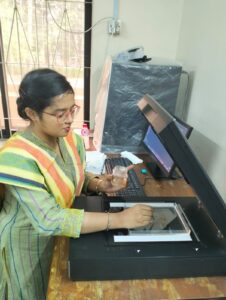Our Recent Work
Our research focuses on understanding the impact of heat stress on wheat reproductive and root development through advanced cytological, anatomical and biochemical analysis studies.
✅ Phenotyping :
We analyze plant characteristics in field conditions, assessing traits like plant height, leaf structure, yield, and stress responses.
✅ Root Phenotyping:


We are also performing root sectioning to examine xylem and phloem development under heat stress. By counting xylem and phloem numbers, we aim to understand how heat stress impacts root vascular architecture, which is essential for water and nutrient transport in wheat.
✅ Physiology :
Chlorophyll measurement provides insights into plant health and photosynthetic efficiency. We use SPAD meters and spectrophotometric analysis to determine chlorophyll levels.
✅ Biochemical Analysis:
Our biochemical research focuses on understanding heat stress tolerance mechanisms in wheat at the molecular level. One key aspect of our study is analyzing proline accumulation, an important osmoprotectant that helps plants cope with heat-induced stress. By measuring proline levels, we aim to assess the plant’s stress response, cellular stability, and adaptive mechanisms under high-temperature conditions.
✅ Cytology :
We are currently testing pollen viability and quantifying pollen number to assess the effect of heat stress on wheat fertility. These observations help determine how high temperatures influence pollen production and viability, which are critical for successful fertilization and grain formation.
Pollen viability is assessed through staining techniques and microscopy to determine reproductive efficiency and fertility in different plant genotypes. Using a Nikon 50iX microscope, we are analyzing the stigma-anther interaction at three different phases:
Optimum phase
Late phase
Very late phase
These observations, conducted under field conditions, help us understand how heat stress affects pollen reception, fertilization efficiency, and overall reproductive success.
✅ Anatomy:
Structural analysis of plant tissues, including leaf, stem, and root anatomy, is conducted to understand adaptations, vascular development, and responses to environmental stresses.
Our research aims to enhance plant productivity, stress resilience, and overall sustainability in agricultural systems. Stay connected for updates on our findings!
Previous Work
Molecular Genetics
I have achieved an extensive research skill in wheat molecular genetics during my PhD from The University of Western Australia, Australia. I identified novel candidate genes, DNA markers and protein biomarkers using genotype-phenotype association analysis, linkage mapping and proteomics, respectively. I phenotyped roots from near-isogenic lines (NILs) and recombinant inbred lines (RILs) of Synthetic W7984 Opata 85 growing in a high-throughput semi-hydroponic system. I used a wheat 90K Illumina iSelect array for genotyping NIL pairs and identified 15 putative candidate genes with three novel genes for root traits. I identified three protein biomarkers for total root length and root dry mass. Which were validated by qRT-PCR. Additionally, I found 14 QTL for root traits from the RILs, including two validated QTL for rooting depth and root mass. Besides plant genetics, I have work experience in marine genetics. I was a research assistant (RA) in two industrial projects—Anti-marine growth structures and transforming Australia subsea equipment reliability—in DNA lab at the UWA. My responsibilities were to extract DNA and RNA from the diverse marine biospecimens for further downstream processes such as genome sequencing and gene analysis.
Biotechnology
I have research experience in both plant and microbial biotechnology. I was a RA in “Production of doubled haploid plant through pollen embryogenesis of Brassica rapa” in the Department of Biotechnology at Sher-e-Bangla Agricultural University (SAU). I used Murashige and Skoog media for growing haploid mustard plants from pollens collected from the anthesis period. In my MSc in Applied Biotechnology at the University of Westminster, UK, I developed antibacterial Polyhydroxyalkanoates (PHA) by incorporating eucalyptus oil into the PHA extracted from Bacillus subtilis OK2. I used fourier-transformed infrared spectroscopy, gas chromatography-mass spectroscopy, nuclear magnetic resonance spectroscopy analysis to identify the PHA, and differential scanning calorimetry and gel permeation chromatography to characterize the biomaterial.
Plant Breeding
During my MS in Genetics and Plant Breeding (GEPB) at SAU, I selected two high-yielding and short-durable advanced lines of Brassica rapa through genetic variability analysis of eleven lines with three replications grown in field conditions at the GEPB experimental farm. Further I led two research projects—“Selection of some hot chili (Capsicum frutescens) genotypes grown in various conditions: Bangladesh”, and “Tolerance of some weeds associated with winter crops in response to the saline environment”, funded by SAU Research System, and the Ministry of Science and Technology, Bangladesh, respectively. I selected salinity and water-logging-resilient Capsicum frutescens and salinity stress-tolerant common weeds of Bangladesh by analysing their morpho-physiological attributes. The physiological analysis was done in collaboration with the Bangladesh Agricultural Research Institute.



